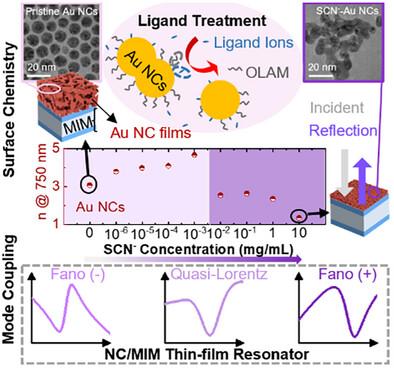Chemically Programmable Fano Resonances via Colloidal Nanocrystal-Ligand Chemistry for Ultra-Sensitive Ion Detection
IF 19
1区 材料科学
Q1 CHEMISTRY, MULTIDISCIPLINARY
引用次数: 0
Abstract
Thin-film-based Fano resonators (TFFRs) offer a promising route to scalable, high-sensitivity refractive index (RI) sensing without complex nanostructure fabrication. However, their vacuum-deposited, porous, and lossy dielectrics are limited compositionally to perform ion detection in biochemical applications. This study introduces an ion-responsive TFFR platform by integrating two resonators, namely a colloidal metal nanocrystal (NC) film and a metal–insulator–metal (MIM) cavity. Upon precise ligand ion treatment, the solution-processed NC film can provide widely tunable RI for coupling with the MIM cavity, enabling continuous spectral tuning of the TFFR between Fano and Lorentzian line shapes in calculations. It showcases this design using Au and Ag NCs and SCN− and Cl− ligand ions, respectively. Chemical, structural, and optical analyses track the RI evolution within the NC film as the ligand ion concentration changes stepwise from 1 × 10−6 to 10 mg mL−1, revealing reproducibility and sample-to-sample variation <3.5%. The measured distinctive spectral signatures corroborate simulations to enable efficient machine learning algorithms that predict SCN− concentrations below 1 × 10−3 mg mL−1 with 97.4% accuracy. The NC/MIM TFFR achieves electrode-free detection of SCN− and Cl− ions with exceptional detection limits of 245.6 and 3.83 nmol L−1, respectively, in a dynamic range exceeding 10⁷.

化学可编程范诺共振通过胶体纳米晶体配体化学超敏感离子检测
基于薄膜的Fano谐振器(tffr)提供了一种有前途的可扩展、高灵敏度折射率(RI)传感途径,而无需复杂的纳米结构制造。然而,它们的真空沉积,多孔和损耗电介质在化学应用中进行离子检测的成分有限。本研究通过集成两个谐振腔,即胶体金属纳米晶体(NC)膜和金属-绝缘体-金属(MIM)腔,介绍了一个离子响应的TFFR平台。经过精确的配体离子处理,溶液处理的NC膜可以提供广泛可调谐的RI,用于与MIM腔的耦合,从而在计算中实现法诺和洛伦兹线形之间的TFFR连续光谱调谐。它展示了这种设计分别使用Au和Ag nc和SCN -和Cl -配体离子。随着配体离子浓度从1 × 10 - 6逐步变化到10 mg mL - 1,化学、结构和光学分析跟踪了NC膜内RI的演变,揭示了再现性和样品间的变化<;3.5%。测量到的独特光谱特征证实了模拟,可以实现有效的机器学习算法,预测SCN -浓度低于1 × 10−3 mg mL−1,准确率为97.4%。NC/MIM TFFR在超过10⁷的动态范围内实现了SCN -和Cl -离子的无电极检测,异常检测限分别为245.6和3.83 nmol L - 1。
本文章由计算机程序翻译,如有差异,请以英文原文为准。
求助全文
约1分钟内获得全文
求助全文
来源期刊

Advanced Functional Materials
工程技术-材料科学:综合
CiteScore
29.50
自引率
4.20%
发文量
2086
审稿时长
2.1 months
期刊介绍:
Firmly established as a top-tier materials science journal, Advanced Functional Materials reports breakthrough research in all aspects of materials science, including nanotechnology, chemistry, physics, and biology every week.
Advanced Functional Materials is known for its rapid and fair peer review, quality content, and high impact, making it the first choice of the international materials science community.
 求助内容:
求助内容: 应助结果提醒方式:
应助结果提醒方式:


